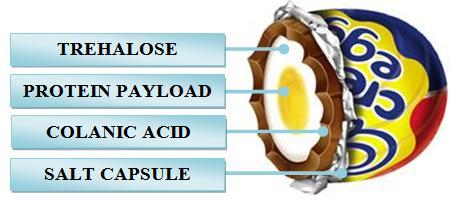Team:Imperial College London/M2
From 2009.igem.org

Contents |
Overview
Module 2 Part i: Encapsulation
The encapsulation phase has been designed to preserve and protect the fragile protein ‘payload’ against the harsh conditions of the outside world.
Insert image of cross-section showing outer salt layer, colanic acid, and trehalose.
RcsB
RcsB upregulates the following genes:
ivy (Inhibitor of Vertebrate lysozyme)
- Discovered in 2001 as the first bacterial lysozyme inhibitor. This Type-C lysozyme inhibitor resides in the periplasm.1
MilC (Membrane-bound lysozyme inhibitor of Type C lysozyme)
- This is a lipoprotein that resides in the membrane. 1
References
- [http://www.ncbi.nlm.nih.gov/pubmed/19136591 The Rcs two-component system regulates expression of lysozyme inhibitors and is induced by exposure to lysozyme]
RcsB downregulates the following genes:
Module 2 Part ii: Trehalose Production
An important consideration when designing the specifications of the E.ncapsulator was the ability to store the cells for extended periods of time. This could be achieved by dehydrating the cells. However, normally under such conditions there poses a problem to maintaining the integrity of the proteins within the cells. This is problematic for us, as this could lead to breakdown of our protein of interest.
In order to preserve the integrity of our protein of interest during storage of the E.ncapsulator, we decided to incorporate a device for trehalose production within our system. Trehalose is a disaccharide formed from two glucose molecules. Throughout nature, trehalose is associated with resistance to dessication and cold shock, and is naturally produced in Escherichia Coli. We hope that by upregulating the trehalose production pathways in E.coli we can increase trehalose concentrations within our cell, thereby conferring some resistance to protein degredation in our system. This would allow easy transport and storage of the final product.
The trehalose coding region in E.coli consists of 2 genes, OtsA and OtsB - each coding for a different enzyme required for the conversion of glucose to trehalose.
 "
"




